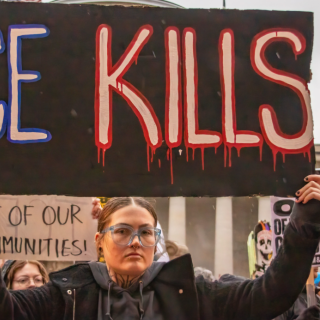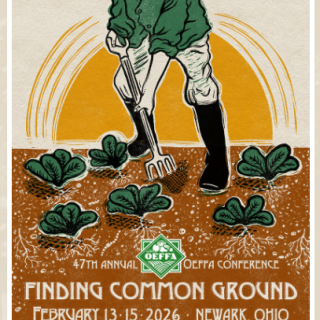When it comes to hitting the doors and dealing directly with the people on the other side, when you rap your knuckles on the wood, you need to remember that you are employing a very powerful weapon effectively and responsively. Meeting people directly is persuasive, so know what you are doing.
Doorknocking to build an organization is not simply canvassing.
Canvassing is a valuable, but abbreviated way to distribute a message with the specific result of either moving a vote or producing a donation. The response to the visit is highly structured to achieve maximum impact in these directions.
There is certainly a structure to a home visit on the doors, but at its core, listening is still the primary requirement. The outcome is uncertain and exciting. The visiting team or organizer needs to be able to hear the issues and interests of the person on the other side of the exchange in order to be able to respond effectively about whether the organization and collective action is possible. At the same time, the organizing team needs to communicate effectively what the organization is and, equally important, what it is not, who should belong, and who should not.
In canvassing, too often the objective is so targeted to results that the “rap” paints a “one size fits all” solution to any problem. In direct visits in community organizing, such an approach is perilous and invariably will lead to conflict at some point in the future when promises and expectations diverge.
In doorknocking, there is a realization that anyone who becomes a member or commits to the organization will be a recurring presence in the organization, so there are consequences to anything other that the full story and the factual realities. In canvassing, this visit is part of “turf,” and the odds are the canvasser will never see this door again, and even if the turf is recycled again, the next canvasser can – and will – disclaim any problems, and go on to the next door.
Besides the fact that such visits, when done well, will build an organization, it is worth understanding that the power of such persuasion has been well documented. In a political context, ACORN’s work on this score has been studied extensively. Alan Gerber of Yale and Professor Donald Green of Columbia note the effectiveness of such work in a 2016 jointly authored paper entitled, “Field Experiments in Voter Mobilization: An Overview of Burgeoning Literature”:
Two experiments conducted in 2003 gave early indications that advocacy campaigns could be quite effective in mobilizing voters. In Kansas City, the ACORN organization canvassed extensively in predominantly African American precincts. Its aim was to identify and mobilize those supportive of a ballot measure designed to preserve local bus service. Unlike most other canvassing experiments, this one was randomized at the level of the precinct, with fourteen assigned to the treatment group and fourteen to the control group. Among voters assigned to control precincts (N = 4,779), turnout was29.1 percent, compared to 33.5 percent in the treatment group, 62.7 percent of whom were contacted (Arceneaux 2005). At roughly the same time, ACORN canvassed in Phoenix on behalf of a ballot measure to determine the future of the county hospital (Villa and Michelson 2005). ACORN conducted two rounds of canvassing, the first to identify voters sympathetic to the ballot measure and a second to urge supportive voters to vote. The canvassing effort targeted voters with Latino surnames who had voted in at least one of the previous four elections. ACORN made multiple attempts to contact voters (including making a small number of phone calls), the result being that 71 percent of those living in one-voter households were contacted at least once. This figure rose to 80 percent among two-voter households. This mobilization campaign had a powerful effect on turnout. Among one-person households, turnout rose from 7.4 percent in the control group (N = 473) to 15.9 percent in the treatment group (N = 2,666). Among two-person households, turnout rose from 6.9 percent in the control group (N = 72) to 21.0 percent in the treatment group (N = 2,550).
Yes, this is a bit academic with the N’s equally this, that, and the other, and, yes, this is study of voter canvassing, which is distinguished from classic, ACORN model doorknocking, but the point of its effectiveness is clear. When Professor Green and colleagues compared the work to direct mail, phone banking, and other methodologies, door-to-door won hands’ down.
This isn’t just true in the United States. Arguably form our experience it is true everywhere. Take France for example. In an article in the 2018, American Economic Review, Vincent Pons from the Harvard Business School described an effort where 80,000 volunteers hit more than 5 million doors in the 2012 election between Francoise Hollande and Nicholas Sarkozy. He found that the,
…campaign increased Hollande’s vote share by 3.2 percentage points in the first round of the election, and 2.8 percentage points in the second round. “Multiplying these estimates by the fraction of French doors knocked, I obtain that the canvassing campaign accounted for approximately one-half of Hollande’s lead in the first round and one-fourth of his victory margin at the second round.” Highlighting the power of a five-minute, in-person conversation with a potential voter, Pons concludes that even short discussions have the power to sway important decisions. “This finding may have implications that reach beyond political campaigns to persuasive communication directed at consumers, donors, or investors,” he writes.
Like I said. Doorknocking is a super powerful tool in community organizing methodology, so take the time, learn the methodology well, count closely, and do the math, because it can make changes and move mountains and people along with them.



